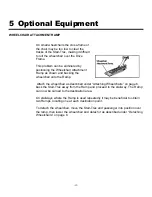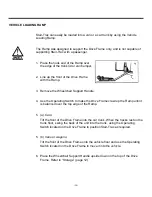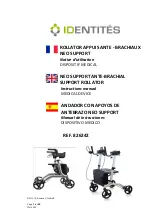
-14-
3. Curbs or ridges higher than 50 mm (2 in) should be crossed by
backing
Stair-
Trac over them, powered by the tracks. For ridges less than 50 mm (2 in) that
Stair-Trac cannot easily rollover, simply lift upward on the handle and press the
left side of the Operating Switch while moving forward over the obstacle. This will
allow the tracks to pull Stair-Trac over the obstacle. Practice this maneuver first
without a passenger.
4. Ope
r
ating Stair-Trac near the inner core of a stairway will keep the stair
w
ay clear
for pedestrians, facilitate turning corners at the landings and provide your
passenger with an added sense of comfort.
5. A slight bump may occur as the Auxiliary Wheels rollover the first stair nose. This
is normal. If the tracks slip and can't seem to push Stair-Trac past this point,
simply lift up slightly on the handle while Stair-Trac is moving backwards. This
will provide added traction between the tracks and the
floor,
allowing the Wheels
to ride over the first stair nose.
6. On some stairways Stair-Trac may “bump” slightly at one or two points during
ascent or descent. This will not happen on all stairways, and occurs because the
spacing between lugs on the tracks does not always coincide with the spacing
between stair noses. When the top of a lug contacts a stair nose the Stair-Trac
will shift slightly to position the base of the track on the stair nose, resulting in a
slight “bump”. There is no cause for alarm as Stair-Trac is perfectly stable and
safe. You should inform your passenger that these “bumps” may occur so the
passenger is not alarmed.
7. The red “STOP” mark identifies the balance point of Stair-Trac. Under most
conditions the mark is accurate; however, balance points will vary depending on
the size of the wheelchair and the weight of the passenger. Always use caution
when tilting Stair-Trac backward or forward at this point.














































